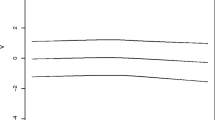Abstract
Recently several new attempts have been made to find a robust method for comparing the variances ofJ dependent random variables. However, empirical studies have shown that all of these procedures can give unsatisfactory results. This paper examines several new procedures that are derived heuristically. One of these procedures was found to perform better than all of the robust procedures studied here, and so it is recommended for general use.
Similar content being viewed by others
References
Box, G. E. P. (1953). Nonormality and tests on variances.Biometrika, 40, 318–335.
Bradley, J. V. (1980). Nonrobustness inZ, t, andF tests at large samples.Bulletin of the Psychonomic Society, 16, 333–336.
Brown, M. B. & Forsythe, A. B. (1974). Robust tests for the equality of variances.Journal of the American Statistical Association, 69, 364–367.
Choi, S. C., & Wette, R. (1972). A test for the homogeneity of variances among correlated variables.Biometrics, 28, 589–592.
Cohen, A. (1986). Comparing variances of correlated variables.Psychometrika, 51, 379–391.
Conover, W. J., Johnson, M. E., & Johnson, M. M. (1981). A comparative study of tests for homogeneity of variances with applications to the outer continental shelf bidding data.Technometrics, 23, 351–361.
Fleishman, A. I. (1978). A method for simulating non-normal distributions.Psychometrika, 43, 521–532.
Friedman, M. (1937). The use of ranks to avoid the assumption of normality implicit in the analysis of variance.Journal of American Statistical Association, 32, 675–701.
Han, C. P. (1968). Testing the homogeneity of a set of correlated variances.Biometrika, 55, 317–326.
Han, C. P. (1969). Testing the homogeneity of variances in a two-way classification.Biometrics, 25, 153–158.
Harris, P. (1985). Testing for variance homogeneity of correlated variables.Biometrika, 72, 103–107.
Huynh, H., & Feldt, L. (1976). Estimation of the Box correction for degrees of freedom from sample data in randomized block and split-plot designs.Journal of Educational Statistics, 1, 69–82.
Iman, R. L. (1974). A power study of a rank transform for the two-way classification model when interaction may be present.Canadian Journal of Statistics, 2, 227–239.
Iman, R. L., Hora, S., & Conover, W. (1984). Comparison of asymptotically distribution-free procedures for the analysis of complete blocks.,Journal of the American Statistical Association, 79, 674–685.
IMSL. (1975).Library 1, Vol. II. Houston: Author.
Levy, K. J. (1976). A procedure for testing the equality ofp-correlated variances.British Journal of Mathematical and Statistical Psychology, 29, 89–93.
Lord, F., & Novick, M. (1968).Statistical theories of mental test scores. Reading, MA: Addison-Wesley.
Miller, R. G. (1968). Jackknifing variances.Annals of Mathematical Statistics, 39, 567–582.
Morgan, W. A. (1939). A test for the significance of the difference between the two variances in a sample from a normal bivariate population.Biomerika, 31, 13–19.
Man, E. J. C. (1939). A note normal correlation.Biometrika, 31, 9–12.
Quade, D. (1979) Using weighted rankings in the analysis of complete blocks with additive block effects.Journal of the American Statistical Association, 74 680–683.
Sandvik, L., & Olsson, B. (1982). A nearly distribution-free test for comparing dispersion in [aired samples.Biometrika, 69, 484–485.
Author information
Authors and Affiliations
Additional information
The author would like to thank the reviewers for their very helpful comments on an earlier draft of this paper.
Rights and permissions
About this article
Cite this article
Wilcox, R.R. Comparing the variances of dependent groups. Psychometrika 54, 305–315 (1989). https://doi.org/10.1007/BF02294522
Received:
Revised:
Issue Date:
DOI: https://doi.org/10.1007/BF02294522




